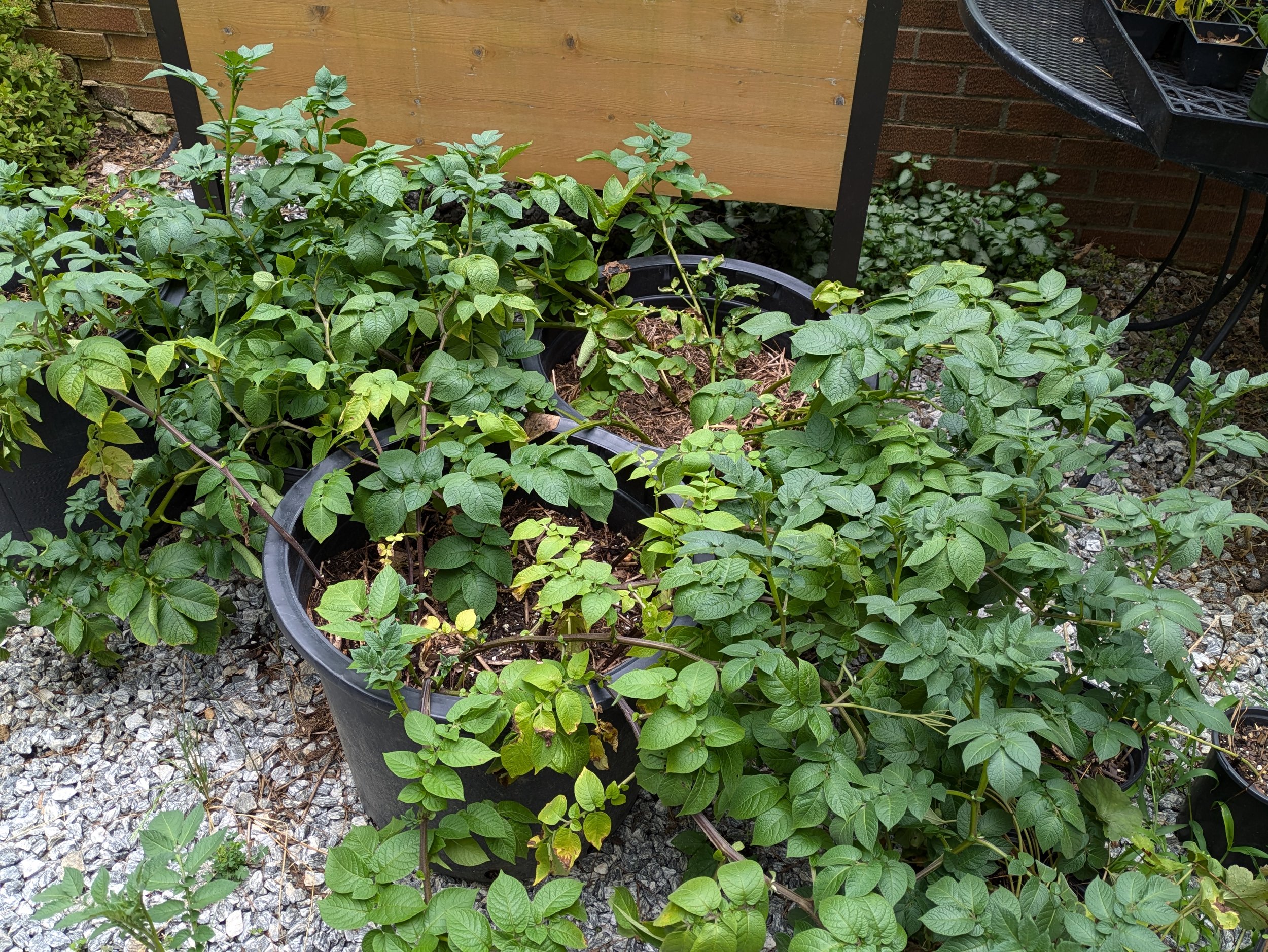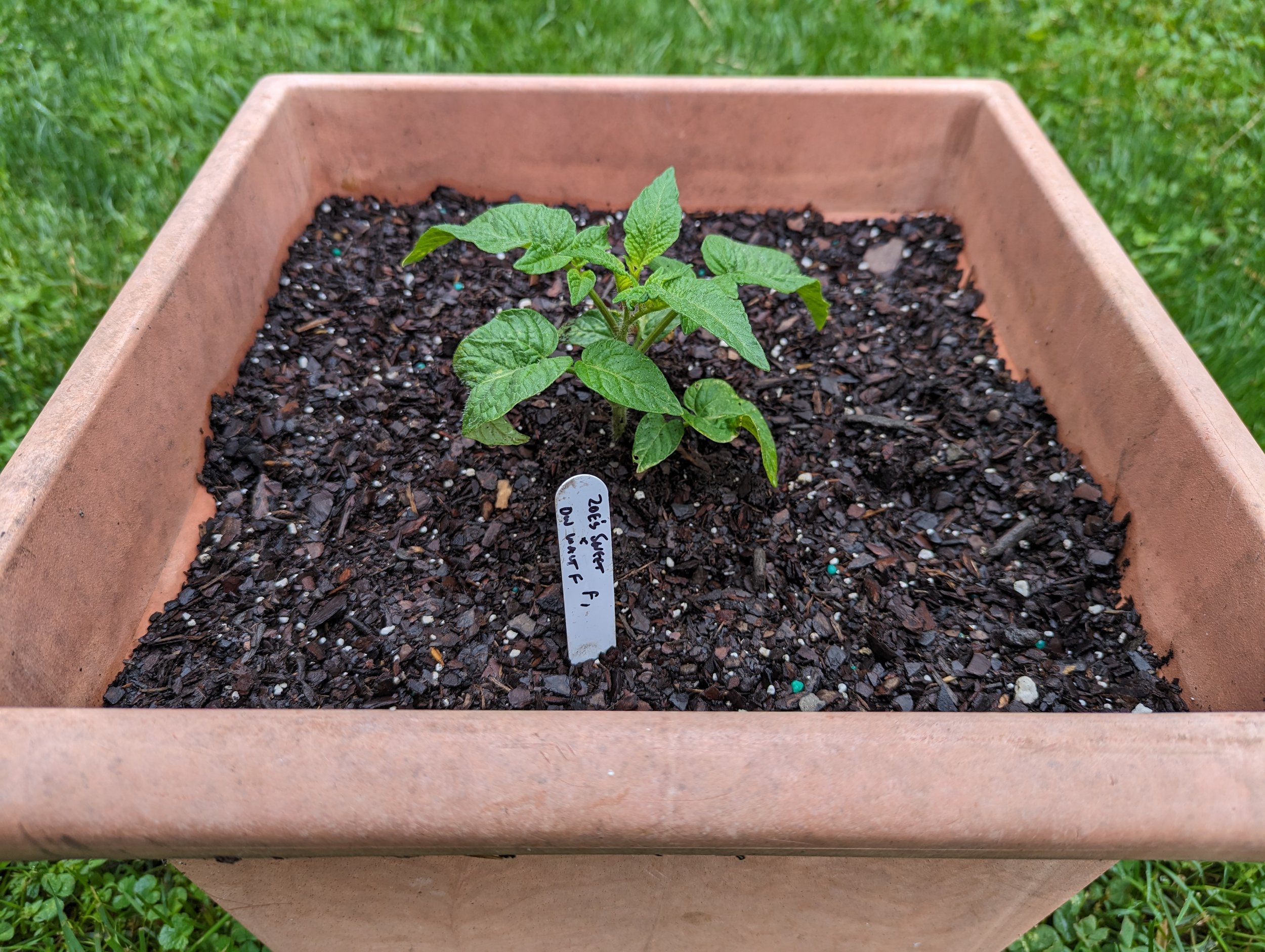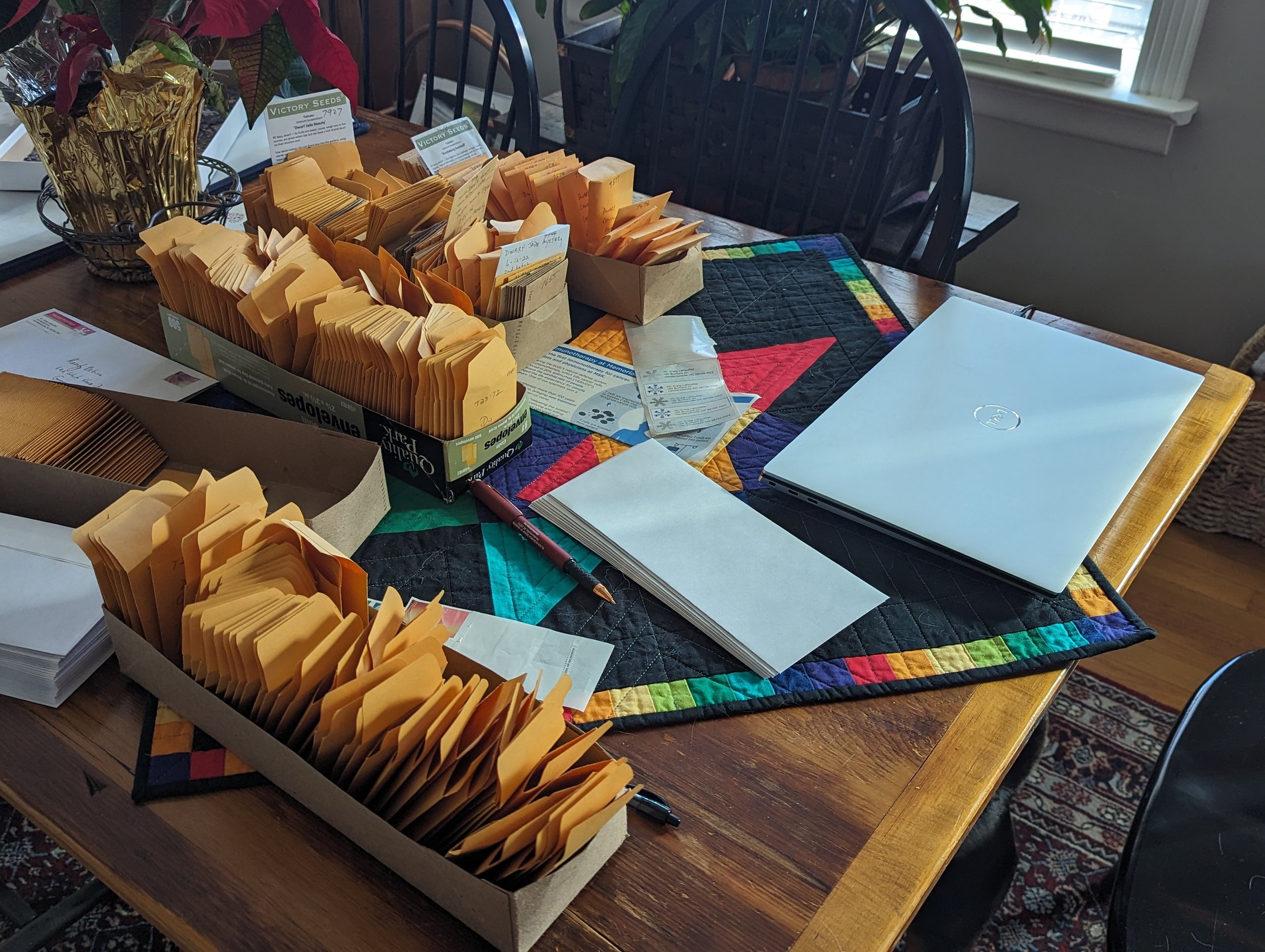Zinnias in one of our 2 new raised beds.
Two weeks ago I talked about the very beginnings of harvest on a few of the main crops. Things change fast, and now everything is coming in, filling our refrigerator, ending up in recipes, being canned - as always, the terror of the harvest is upon us. It is delicious, fun, keeping us busy, and occasionally stress-inducing.
Let’s go crop by crop and see where things are on this steamy Monday afternoon.
Greens in raised beds
spinach and garlic replaced
A few weeks ago spinach was removed (bolting indicated it was high time to do so) from the elevated raised bed. In its place are a few types of basil and a zinnia variety called Cupcakes. The basil is a new one called Emerald Towers, which should emulate the Greek Columnar type available only as seedlings from past gardens. So far, so good.
new lettuce seedlings
We really enjoyed lettuce from one of the new driveway raised beds right through early July, but the heat was bringing on bolting, so it too was removed. In its place are lettuce seedlings I began from seed a few weeks ago. That raised bed is in the shade from early afternoon, so we hopefully can get a month or so of harvest before it decides to bolt. I’ve not planted lettuce this late, so it is an experiment.
The original raised bed that contains collards and kale continues to provide greens, but probably for not much longer. After the garlic was harvested, cilantro was direct seeded, and it is up and growing well.
Swiss Chard
We continue to enjoy Swiss Chard from both new raised beds, and hope to keep it going well into the summer.
Potatoes in large containers filled with last year’s spent wheat straw
potatoes in large containers
The plants in all four containers continue to flourish. One the tops yellow and die back I will go digging to see what kind of yields were obtained. Potatoes will never be a primary crop for us, but Bill Minkey’s generosity provide an annual opportunity to grow some unique types in our driveway.
Fowler bush bean in a driveway container
Fowler was the first seed requested upon joining the Seed Savers Exchange; aside from being an excellent green snap bush bean, it has real meaning for me due to the SSE association. I was very low on viable saved seed, so decided to grow 8 plants in a 10 gallon container on my gravel driveway. I started them indoors in early spring, and over the last few weeks harvested quite a few pods that hung on the plants until they became yellow. I still have perhaps 10 more pods to harvest, but already have 150 or so good seeds that I can use for my strawbale bean plantings next summer.
Cucumbers in a strawbale
A perfect Deli Star F1 ready to pick
My friend Sam, from the UK, sent me seeds of a few of her favorite cukes that are not easy to find in the US. We started picking cukes from both types over the last few weeks, and they are simply delicious - sweet and crunchy and with no need to peel. The shorter one, Deli Star hybrid, is 6-8 inches long and pale green; Carmen hybrid grows to a foot long or more, is dark green and ribbed and similarly sweet, crunchy and wonderful. Sue has already made pickled out of them both. The plants remain healthy and flowering and setting more cukes. I typically lose cuke plants early due to virus likely spread by striped and spotted cuke beetles, but so far, so good this year. I have a total of 5 plants of the above. A rare Italian variety is growing (2 plants) but not provided any cukes yet.
Bush snap beans in 3 rows in 4 pushed together strawbales
Marbel bush snap filet bean
We’ve had an avalanche of beans for a few weeks now, and every day are provided with a gallon bag. Needless to say we are eating (and enjoying) them daily, though we’ve also frozen 2 gallon bags. All 5 varieties are growing beautifully and yielding heavily. We have half rows of Marbel (very slender, long pale green with lavender stripes), Maxibel (very slender, long green), Endeavor (typical bean diameter, a bit shorter, green), Roc d’Or (slender very long yellow wax), and a full row of Goldilocks (long slender yellow). We love them all, but have to be careful not to let Marbel grow too long, as it rapidly develops strings.
Summer Squash - 4 hills, one each in 4 pushed together strawbales
Zephyr, of course!
I don’t think I’ve ever experienced such a heavy yield of our favorite summer squash, Zephyr. Going to one plant per bale seemed to not diminish our squash quantity a bit (two years ago we had 16 plants - yes, that’s insane - last year we had 8 - and this year only 4). The zucchini variety we are growing is Emerald Delight - lovely, but thankfully nowhere near as prolific as Zephyr. The 3rd variety is the round dark green zucchini type called 8 Ball - it is also slower to grow and yield, thus providing us with some relief. Sue made a batch of zucchini bread and we are preparing it various ways to enjoy with our meals.
Peppers - it turns out I’ve got 2 plants of Shishito
Shishito peppers
I had a mislabeling error, so instead of Shishito and Pinata, two gorgeous Shishito plants are taking up a strawbale. They are being grown caged and today we had our first decent harvest. On to the grill they go tonight. We are going to have a lot of Shishito peppers this year.
Eggplants - harvest is imminent on 2, and 2 more were recently planted
Mardi Gras eggplant on the way
The garden strawbale containing the varieties Twilight Lightning (slender, long, white with lavender) and Mardi Gras (teardrop medium light green with a purple blush) is about to provide its first specimens of each. The plants are caged, healthy, and set to be very productive. I put into use one of our self watering containers sent by Gardeners Supply to rest and evaluate. Into that are seedlings of Midnight Lightning (slender, long, black purple fruit, heavily purple blushed foliage) and Skinny Twilight (slender medium purple fruit, green foliage). We are a few weeks away from seeing fruit on them, which is fine.
Tomatoes - it is just about that time!
The tomatoes will be more of a mixed bag than usual, as a few issues have already arisen. Let’s get to the plants one by one.
New hybrid Dwarf Walter’s Fancy X Dwarf Choemato, 10 gallon container, caged
Dwarf Walter’s Fancy X Dwarf Blazing Beauty F1
The gorgeous potato leaf dwarf plant is loaded with medium sized oblate tomatoes. A few ripened prematurely due to blossom end rot (proving to be a stubborn issue this season for me, which is very unusual). The two parents are ivory and yellow/red bicolor. The hybrid appears to be yellow with a red blush. I tasted a small piece and found it really nice (though the flavor of the hybrids is not that critical). On the plant is a tomato that is a cross with Cherokee Chocolate - I must keep track of it for future seed saving. This variety is being grown out primarily for seed saving and future work.
New hybrid Dwarf Walter’s Fancy X Dwarf Blazing Beauty, 10 gallon container, caged
Similarly gorgeous and fruit-laden, the tomatoes on this will be medium to a bit larger and oblate. One prematurely ripe tomato (due to BER) shows that it will surprisingly be a scarlet red tomato (the parents are ivory and orange). I didn’t taste any, as the tomato had very little that was appealing to it due to the extensive BER damage. As with the variety above, it is being grown primarily for seed saving and future work. I did attempt a cross with Lucky Cross, and it looks promising.
New hybrid Dwarf Walter’s Fancy X Dwarf Zoe’s Sweet, 10 gallon container, caged
This is the third of the new hybrids I made that are primarily for seed saving and future work. This will be a medium pink tomato - the plant looks great and has lots of green fruit. Work with saved seed will be interesting, as this is a starting point for a chartreuse, variegated leaf, potato leaf dwarf variety. I attempted a cross with Cherokee Chocolate and it looks promising.
Sun Gold hybrid, growing in its own strawbale, caged
Whole lotta Sun Gold on the way
We harvested the first ripe fruit today, 68 days from planted seedling. They are as expected - round, orange and just delicious. The main issue with plant has been septoria leaf spot, so the plant keeps me busy with removal of blemished leaves. I guess this has to be considered issue #1 for my 2024 tomato growing. Being grown unpruned, yield should be very heavy.
Cherokee Purple, growing on its own in a strawbale, 4 fruiting stems, 2 stakes
This long time favorite is giving me headaches (for the first time). The healthy plant is setting lots of tomatoes, but I’ve had to remove at least 20 due to blossom end rot. I still hope to have a reasonable yield, but I wonder if something is up genetically with the particular plant I decided to grow. The plants at the Vet Farm from the same seed are not having the BER issue. This is just one of several mysteries emerging in this year’s garden. This is issue #2.
Polish - growing on its own in a strawbale, 4 fruiting stems, 2 stakes
A sick Polish
Here is issue #3 - one major stem had to be removed due to suspected Fusarium wilt. It would be a shame to lose this plant because it is loaded with green tomatoes. The plants at the farm from the same seed are just fine. Am I starting to build up tomato diseases in my yard? It’s one thought I have. Polish has never given me trouble in the past, and I’ve been growing it since 1990.
Potato Leaf Yellow - growing on its own in a strawbale, 4 fruiting stems, 2 stakes
Potato Leaf yellow
All is well with this plant, with heavy fruit set and excellent plant health. The pruning on this plant allows for easy following of main stems and flower clusters.
Captain Lucky - growing on its own in a strawbale, unpruned, caged
It is interesting to compare an unpruned caged indeterminate with its pruned neighbors. Aside from some lower septoria leaf spot, this plant is growing very well and setting plenty of fruit. One developing tomato is a cross with Sun Gold, which should provide some fun to play with going forward.
Egg Yolk - sharing a bale with Mexico Midget, unpruned, caged
Egg Yolk and Mexico Midget monstrosity
The complexity of this plant with the next in a single strawbale is unreal. When the large cherry tomatoes produced on this favorite start to ripen, we will be inundated. There are no issues at all with this one.
Mexico Midget - sharing a bale with Egg Yolk, unpruned, caged
Mexico Midgets ready to pick
See my Egg Yolk write up, above. The only thing bothering Mexico Midget is some lower early blight foliage, which is immediately removed. Fruit set is heavy and we ate the first in 54 days from planting. Harvesting from this bale will be an ordeal - but a useful and delicious one. The mass of green is over 3 feet in width, and over 6 feet tall in height.
Abraham Brown - growing on its own in a strawbale, 4 fruiting stems, 2 stakes
This very well behaved, monster plant put on its first fruit clusters quite high up on the vine. Aside from some lower septoria, there are no issues with this variety (yet) - it will be quite late ripening, I believe.
Lillian’s Yellow Heirloom - growing on its own in a strawbale, 4 fruiting stems, 2 stakes
Now for issue #4. A disease seems to be slowly working up the plant and has caused some stunting of growth. There is a brown patch at the junction of the leaf stem and main stem, and the main vein of the leaf eventually turns brown. Yet, the top of the plant is setting fruit and looks fine. I have a few suspicions - pith necrosis or collar rot being 2 disease candidates.
Lucky Cross - growing on its own in a strawbale, 4 fruiting stems, 2 stakes
Another very well managed, well behaved plant, all is well with Lucky Cross save a few instances of blossom end rot on green young tomatoes. I expect that we will get a very good harvest of large, tasty tomatoes from this perennial favorite.
Cherokee Green - growing on its own in a strawbale, 4 fruiting stems, 2 stakes
This has been the densest, most challenging to prune plant in the garden. Seed for this selection is from 2016, which is the last link to Cherokee Green from the find in my garden (all others I’ve grown recently originate from Johnny’s Selected Seeds company seeds). There are some instances of BER but the plant looks great and fruit set will be heavy. I am anxious to see what this one gives.
Earl - growing on its own in a strawbale, 4 fruiting stems, 2 stakes
Well behaved Earl
This is the best behaved tomato plant in this year’s garden, and the pruning and staking technique clearly suits it well. This is the first tomato I’ve topped this year, both fruiting stems on the primary stake. If all holds well, we will get a lot of these to eat.
Cherokee Chocolate - growing on its own in a strawbale, 4 fruiting stems, 2 stakes
The largest number of tomatoes in a cluster goes to this Cherokee Chocolate plant - which, alas, looks as if it is not Cherokee Chocolate. The first tomato to ripen (due to BER) showed it to be scarlet red, indicating a cross. I do hope that it tastes good because we are going to get a lot of them. The plant is very dense, complex, and healthy.
Lots of (not) Cherokee Chocolates

































































